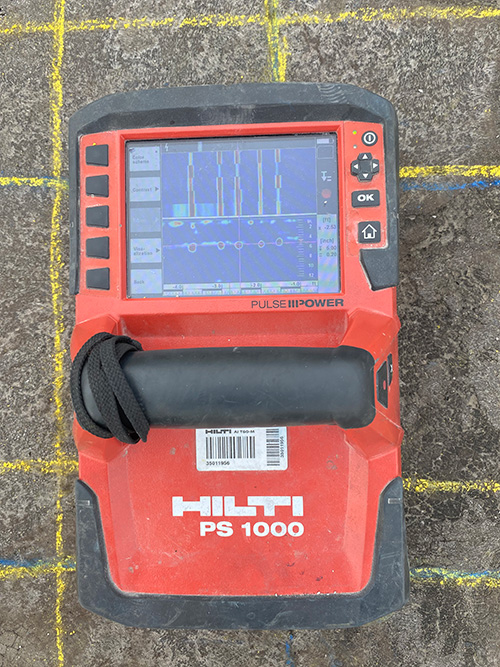Enhance Construction Safety And Security with Specialist Concrete Scanning
Past the Surface: Leveraging Advanced Concrete Scanning Techniques for Unmatched Precision and Understanding
In the realm of building and construction and framework maintenance, the pursuit for accuracy and thoroughness is never-ending. Advanced concrete scanning methods have become vital devices in this quest, offering a look below the surface to unveil a globe of critical understandings. By utilizing sophisticated innovations, professionals can discover abnormalities, evaluate the problem of concrete structures, and make educated decisions that form the course of tasks. The ramifications of these strategies prolong far past simple surface-level assessments, promising a depth of accuracy and understanding that is unparalleled.
Importance of Advanced Concrete Scanning
The relevance of making use of innovative concrete scanning techniques hinges on the unmatched accuracy they offer for discovering sub-surface abnormalities and ensuring structural integrity. By employing advanced innovations such as ground-penetrating radar (GPR), electro-magnetic induction, and advanced sonar imaging, construction professionals can delve below the surface of concrete structures with a level of accuracy that far surpasses conventional evaluation techniques. Concrete Scanning. These techniques enable the identification of hidden hazards like rebar corrosion, gaps, avenues, or post-tension wires that can endanger the security and security of a structure in time
Furthermore, advanced concrete scanning provides invaluable understandings right into the general condition of a concrete element without the need for intrusive actions, minimizing the risk of causing damage during the analysis process. The capacity to determine the exact place and deepness of possible concerns enables targeted repair work and upkeep, inevitably prolonging the life expectancy of the structure and optimizing its performance. In essence, the significance of innovative concrete scanning can not be overstated in the realm of construction and framework maintenance, where accuracy and integrity are critical.
Kinds of Cutting-Edge Technologies

Anomalies and Problem Detection

In addition to GPR, concrete scanning techniques like thermography and impact-echo screening are additionally efficient in spotting abnormalities and problems. By leveraging these innovative strategies, specialists can proactively address structural concerns, guaranteeing the longevity and safety of concrete frameworks.
Assessing Concrete Problem
Just how can designers accurately evaluate the problem of concrete structures to guarantee their durability and security? Different innovative concrete scanning methods are utilized for this objective. Ground-penetrating radar (GPR) is typically utilized to analyze the internal structure of concrete, detecting spaces, fractures, and various other abnormalities that may jeopardize its toughness.
Combining non-destructive testing methods with visual evaluations enables for an extensive analysis of concrete problem, enabling engineers to determine prospective problems early on and implement timely maintenance or repair work. By leveraging these sophisticated methods, designers can make sure the long-lasting toughness and safety of concrete structures.
Enhancing Decision-Making Processes
In the realm of infrastructure monitoring, enhancing decision-making procedures is important for making sure the effective upkeep and durability of concrete structures. Enhanced decision-making procedures in concrete management involve using sophisticated scanning techniques to collect comprehensive data on the condition of frameworks. By leveraging modern technologies such as ground-penetrating radar and over here 3D imaging, stakeholders can make educated decisions regarding support, repair work, or substitute techniques.
These advanced scanning strategies offer indispensable understandings into the inner structure of concrete, determining possible problems such as voids, cracks, or deterioration that may not show up externally. This degree of comprehensive details enables for proactive upkeep preparation, reducing the risk of architectural failures and increasing the total life expectancy of concrete structures.
In addition, by incorporating electronic documents read this post here and evaluation tools into the decision-making procedure, stakeholders can track the development of concrete problems in time, enabling anticipating upkeep strategies and maximizing resource allocation. Eventually, the integration of sophisticated concrete scanning strategies boosts decision-making procedures by supplying unequaled precision, insight, and efficiency in infrastructure monitoring.
Verdict
To conclude, progressed concrete scanning methods provide unmatched precision and insight in discovering anomalies, defects, and analyzing the problem of concrete frameworks. By leveraging innovative innovations, decision-making processes can be boosted, causing more efficient and informed remedies for preserving and repairing concrete infrastructure. These techniques play an essential role in making certain the safety and security and long life of concrete frameworks, making them an essential tool in the area of building and construction and design.
Additionally, advanced concrete scanning provides indispensable insights into the overall condition of a concrete element without the need for invasive actions, lessening the danger of causing damages throughout the analysis process - Concrete Scanning. Another innovative modern technology is 3D X-ray scanning, which gives comprehensive images of the internal framework of concrete, using important info without the need for devastating testing. In Addition, Concrete Cover Meters are utilized to measure the density of concrete cover over reinforcement bars properly. Enhanced decision-making procedures in concrete management include utilizing sophisticated scanning techniques to gather thorough data on the problem of frameworks.In verdict, advanced concrete scanning methods use unequaled accuracy and insight in discovering Click This Link abnormalities, issues, and examining the condition of concrete frameworks